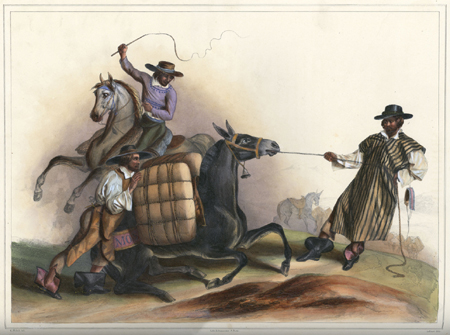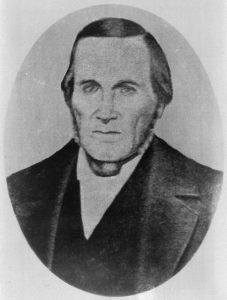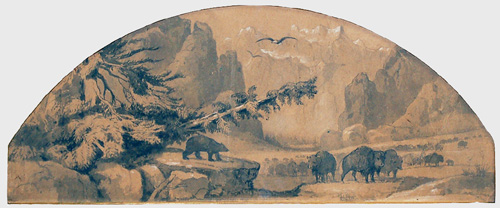The Old Spanish National Historic Trail
by Elizabeth von Till Warren
(First appeared in the 2004 Summer Issue of “Pathways Across America”, a newsletter published by the Partnership for the National Trail System – PNTS)
The Old Spanish Trail became the fifteenth national historic trail when Congress adopted S. 1946 in November and President George W. Bush signed the bill early in December 2002. The Old Spanish Trail linked two provinces of Mexico separated by such difficult topography and climatic extremes that, despite attempts beginning as early as 1776, a route was successfully opened only in 1829. In that year Antonio Armijo, a merchant from Santa Fe, led approximately 60 men and a large mule caravan across a network of known trails blazed northward by trappers and traders with the Utes, and backtracked along the route Spanish padres Dominguez and Escalante recorded as they returned to Santa Fe from southern Utah more than fifty years earlier.

Armijo’s group blazed a trade route utilizing a network of indigenous routes, parts of Jedediah Smith’s routes of 1826 and 1827, and Rafael Rivera’s route of 1828. Armijo avoided the worst of the Mojave Desert, traveling south of Death Valley following intermittent streams and locating springs to support the party. He arrived at San Gabriel Mission in California with his group intact, although the men were forced to rely on mule meat during their final days on the trail. In California, they traded the blankets and other goods carried by packsaddle from Santa Fe for horses and mules, available in great numbers and little valued by the Californios. Several thousand of these horses were driven back to Santa Fe, where they became important in trade with both Chihuahua and St. Louis.
The return journey marked the first time a caravan made a round trip between Santa Fe and Los Angeles, and the governor of New Mexico trumpeted this fact immediately to his superiors in Mexico City. There was finally a land link between these two regions; no longer was Santa Fe so land locked, because California provided access to foreign markets via her seaports. Thus, the international trade between the United States and Mexico via Santa Fe was enhanced by commercial traffic between Santa Fe and Los Angeles.
News of the opening of trade with California resulted in immediate commerce between Santa Fe and Los Angeles. With a few exceptions, pack trains made annual treks between New Mexico and California, bringing woven Mexican products to California, which lacked sheep, and bartering them for horses and mules, scarce in New Mexico. Emigrants from New Mexico began to take the Spanish Trail to California in the late 1830s, and outlaws used the trail to raid the California ranchos. Raids for Indian slaves became common, with victims sold at either end of the trail despite official condemnation of the practice. The traffic in human beings reverberated among the peoples who lived along the trail for many years longer than the caravans plied their trade.
People made use of the Spanish Trail for a variety of purposes, which over time led to the development of several main routes and numerous alternates. The Old Spanish National Historic Trail Feasibility Study recognizes several main routes and the Armijo trace in identifying the period of significance for the trail. The year after Armijo’s journey, 1830-1831, William Wolfskill and George Yount blazed a different route that used some of the same landmarks. Their route, following the Colorado River to Needles, and up the Mojave River to Cajon Pass, was much favored by later travelers. Some trail users chose to trade with the Utes as far north as Salt Lake, and followed a path now labeled the “North Branch,” which led to Grand Junction, Colorado before heading south to rejoin the other major route from Santa Fe via Green River, Utah. Several variants of these two routes were also used, but all came together in southern Utah, fanning out once again into separate trails from southern Nevada to southeastern California. They came together again at the Mojave River, which brought travelers to the Cajon Pass portal of southern California. The group of main trails and alternates together form the Old Spanish Trail.

Americans became aware of the trail with the publication of John C. Frémont’s Report of his 1844 journey from California to the States, the return leg of his expedition to Oregon for the U.S. Topographical Corps. Frémont’s Report created a sensation in Washington, already struck with Manifest Destiny fever. Frémont took the Spanish Trail across to Utah. People called the route by various names, but he called it the “Spanish Trail” in his Report, and that is the name that has been used ever since. Recognizing that a large area of the interior desert had no connection to the sea, Fremont first called it the “Great Basin”, another name used ever since – in his report.
The Spanish Trail name and use lapsed after the War with Mexico ended in 1848. There was no longer any need to link Santa Fe with Los Angeles by this difficult mule trail; other, wagon-friendly routes were opened. The Spanish Trail was not a route of major emigration to the West; trails to the north and south of it were preferred for this wagon traffic. Spanish Trail caravans continued to trade with the Mormons in Utah, but by 1853 they were no longer welcome there. The New Mexican caravans were out of business.
Popular and academic interest in the trail was only sporadically evident over the ensuing decades. Interest in the trail began to revive beginning in 1921, with the publication of an article by Joseph J. Hill, the 1930 and 1931 work of Eleanor F. Lawrence, and the publication in 1930 of George Brewerton’s Overland with Kit Carson. William R. Palmer of Cedar City, Utah organized the Spanish Trail Association in 1946. This group placed 100 markers along the trail between Santa Fe and Los Angeles, but faded soon after accomplishing this task in 1950. LeRoy and Ann Hafen of Utah published their definitive history of the trail in 1954; this work inspired still other research, and the post WWII jeep made it possible for the general public to explore the desert, stimulating interest in the trail.
Efforts to mark the trail revived. Nevada, in celebration of its centennial, marked the Fremont route in 1964-65. In Utah, the Emery County Historical Society placed markers in the Green River area in the early 1990s, while in the mid-1990s, Iron County Boy Scouts of America marked the trail through their territory. New energy to identify and mark the trail arose among the people of Grand Junction, Colorado in the 1990s as well. This effort focused much attention on the trail’s North Branch, energizing discussions about the Spanish Trail and its importance for the region. Beginning in 1992, a strategy for attaining National Historic Trail designation was laid out by individuals connected with the Riverfront Commission in Grand Junction and the Colorado Board of Parks and Outdoor Recreation.

In 1993 these trail aficionados convinced Colorado’s Senator Ben Nighthorse Campbell and Representative Scott McInnis to introduce a bill authorizing the NPS to study the feasibility of including the Old Spanish Trail in the National Trails System as a National Historic Trail. In 1994, Colorado supporters founded the present Old Spanish Trail Association (OSTA). This group teamed up with the Colorado delegates and senators from New Mexico, Utah, and California to keep the legislation alive. Senator Campbell and Congressman McInnis succeeded in including the Old Spanish Trail feasibility study in the 1996 Omnibus Parks and Public Lands Management Act.
The first draft of the feasibility study, issued in July 2000, found insufficient information to conclude that the Old Spanish Trail was nationally significant. OSTA mobilized its resources and crafted a response, which tipped the scale in favor of national historic trail designation. The NPS Advisory Board voted to recommend inclusion of the Old Spanish Trail in the national trail system, and in July 2001, the NPS issued a final feasibility study that concluded the Old Spanish Trail is “nationally significant within the theme of the Changing Role of the United States in the World Community and the topics of trade and commerce, during the period of 1829-1848.”
Early in 2002, Senator Campbell introduced S 1946, the Old Spanish Trail Recognition Act. In 2002, Congress passed the bill unanimously. Secretary of Interior Gale Norton assigned preparation of a Comprehensive Management Plan to both the Bureau of Land Management and the National Park Service; both agencies are now working on implementing this order, modeled on the approach that produced a plan for managing the Camino Real de Tierra Adentro National Historic Trail in New Mexico. The Old Spanish Trail Association is eager to participate in the preparation of this plan.
Liz Warren is a past-president of OSTA.
